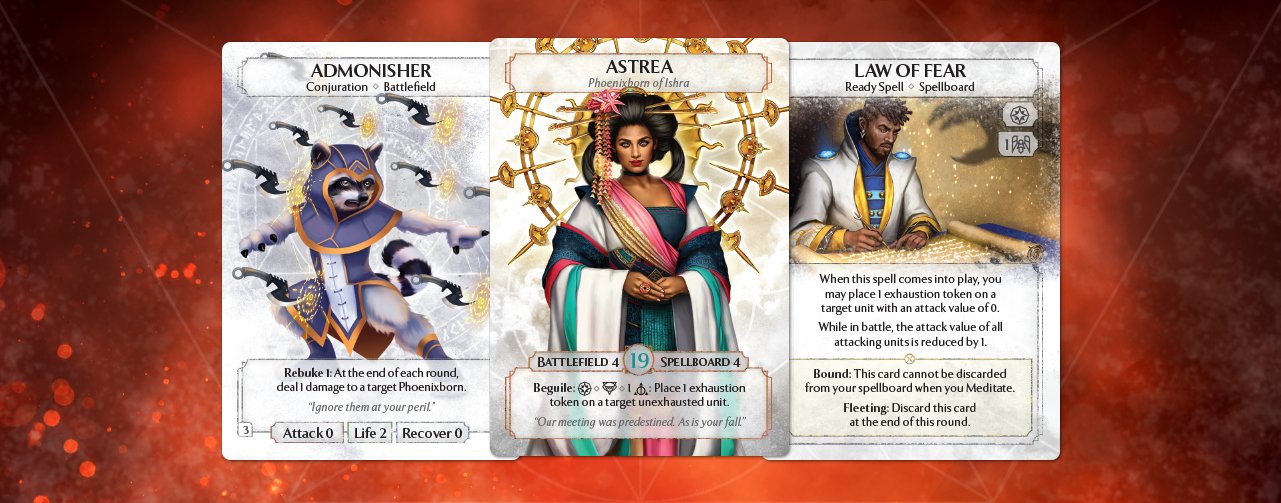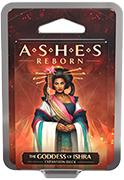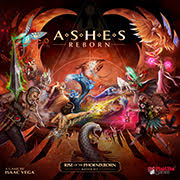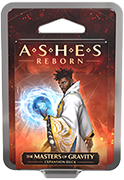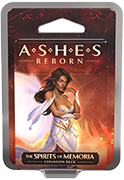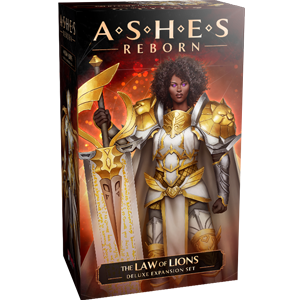Re-Constructed Decks - Astrea
Break out the Rulers
Welcome back, Ashes players, to another installment of Re-Constructed. I know you’ve been playing with other Phoenixborn when Astrea wasn’t looking. Don’t worry, if you grovel she might forgive you.
By this point, you should already know the deck building restrictions we’re working with, and with these divine magic and sympathy magic decks you’ll also need “The Law of Lions” or “The Song of Soaksend” accordingly. Today’s deck is all about control in the way that most Charm decks tend to be, but this entry isn’t about exhaustion. Rather than break down your deck, Astrea is all about breaking down your willpower...admonishing it, so to speak.
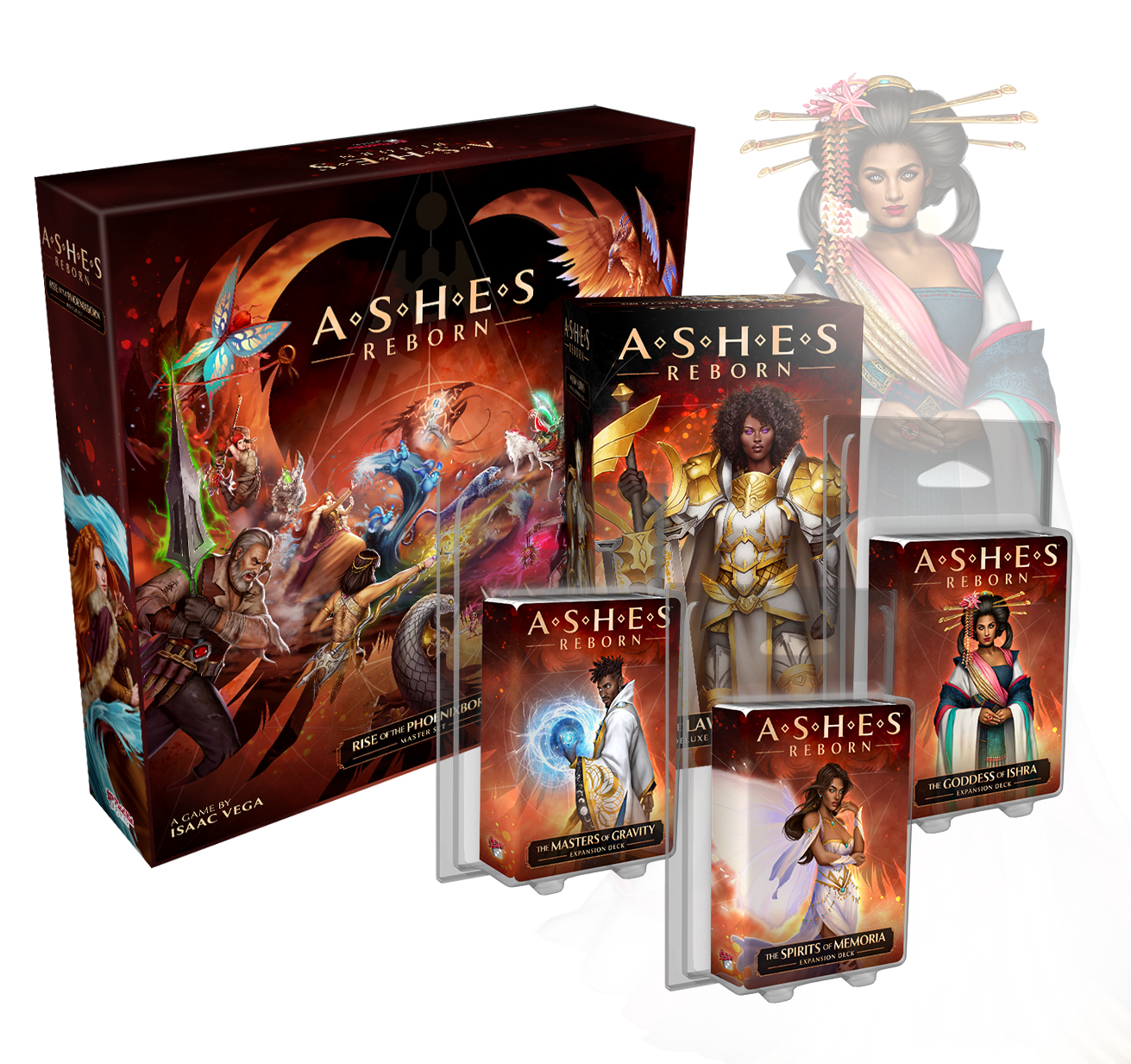
The Messiah of Ishra (Re-Astrea)
Re-Constructed by Andrew DiLullo
6 Divine, 4 Charm // Needed Sets: The Masters of Gravity, The Spirits of Memoria
3x Summon Admonisher
2x Summon Steadfast Guardian
1x Summon Weeping Spirit
3x Law of Fear
2x Royal Charm
2x Chained Creations
3x Kneel
1x Meteor
3x Mark of the Goddess
1x Open Memories
1x Holy Knight
2x Sun Sister
1x Imperial Ninja
2x Holy Relics
1x Call to Action
2x Sympathy Pain
So, Admonishers sound a little strange here. Astrea’s undergone a lot of changes in Ashes Reborn, not the least of which is a further reduction of an already cramped Battlefield. Five slots is tight, but four slots is practically devoid, so why play a unit that will effectively take up your entire battlefield? Let’s put a pin in that for now and start as we usually do: examine what the pre-con is doing. Despite being a 4-battlefield Phoenixborn, Astrea’s deck has three different summon books, which almost feels like a bad joke until you use them. Steadfast Guardian is now limited to one unit and the extra books let you refresh an existing guardian rather than make a new one, which is actually bonkers good. Light Bringer, as we saw in Echo’s deck, are a low conjuration count that are mostly intended to die pretty quickly while forcing your opponent to make lame attacks. Finally, Weeping Spirit is a high conjuration count unit that goes on the opponent’s board instead, allowing us to share the sensation of a cramped playspace. You have a veritable wealth of options for controlling and stalling out progress with Astrea: Sun Sister heals your damaged units, Mark of the Goddess lets you slap an opponent’s unit with a different unit, Kneel just turns the entire board off for a round, and Call to Action enables you to continue chump blocking or guarding even when it seems like you’re completely exhausted. Astrea herself also features one of the strongest Phoenixborn abilities in the game, exhausting any threatening unit for one basic and making her effective battlefield coverage closer to five. Finally, as we highlighted in Leo’s deck, we have Imperial Ninja to apply a certain amount of exhaustion pressure on our opponents. Astrea is amazing at this grindy slowplay, a perfect reification of the concept of full control. Similar to Sunday mass, playing Astrea is a bit of an ordeal, requires a lot of knowledge going into it, and definitely isn’t for everyone, but can be really satisfying to a select few.
Unfortunately, Astrea’s precon can’t really win with an exhaustion gameplan. All you have to help you grind decks down are Weeping Spirit and Imperial Ninja, and a handful of cards that extend the game by about 3-5 rounds. It’s not enough, so I figure we have two options here. Option 1 is stripping the deck down into a traditional exhaustion engine: Another Three-Eyed Owl deck, this time with a cool refresh tool in Devotion, and a spellboard option like Memory Theft or Purge to really force down the opponent’s deck. This is certainly a reasonable choice, but I wanted to lean more into Astrea as a hard control deck that plays with inevitability, and Admonishers feels like the best way to do that. So instead, I’m choosing Option 2, a slow burn deck that is less about highlighting Charm’s strengths and more about highlighting Astrea’s strengths. Best pull out the pews and lay out the prayer mats, cause a whole lot of kneeling is about to happen.
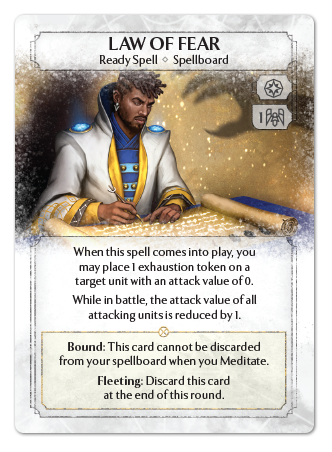
Admonishers are replacing Light Bringers as our primary gameplan, and we’re adding one essential piece of scripture to the spellboard: Law of Fear is an absolutely amazing deterrent, knocking 1 damage off every single attacker coming our way, and it shouldn’t affect us much as we don’t plan on attacking hardly at all. It can also be used as a cheap way to exhaust Three-Eyed-Owls...or donated Weeping Spirits. When I play this deck, I usually think of Law of Fear like a soft Kneel, which means I have roughly six rounds of kneeling to work with. There are still threats that can go through this strategy, especially units with Terrifying, but those threats can be directly addressed by Astrea’s ability. The primary advantage of Law of Fear is simply one of value, just about none of our cards see any detriment from the effect. Steadfast isn’t attacking much, and the reduced power of attackers also means she can guard more effectively. Admonishers have 2 health, which means Law of Fear keeps them alive through Winged Lioness attacks. And luckily, because Law of Fear only weakens attacking units, Mark of the Goddess doesn’t lose any of its potency.
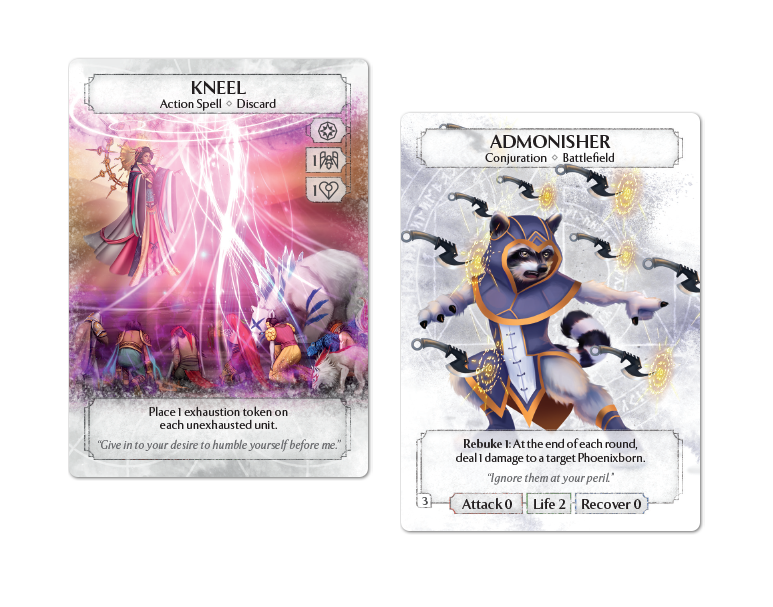
But of course, reading about the grace of Astrea is only the first step, the real lessons come through prayer, and Kneeling is the method. Any Astrea player of course knows the power of Kneel, but it’s actually stronger here than in the pre-con. Because of the timing of abilities, Rebuke 1 actually triggers after exhaustion tokens are removed, meaning that Admonishers can still deal their damage despite being exhausted. Additionally, all your spellboard cards can still be effective with a full battlefield if you have some focus abilities: Steadfast Guardians can be refreshed in place of summoning a new one, and a failure to summon Admonishers instead allows you to deal 1 damage to the opponent directly, effectively turning the summon book into a Frost Bite.
Filling out the rest of the deck are some useful toolbox cards and even a few allies. If I believe I can manage it, I’ll aim for Steadfast plus three Admonishers, but realistically speaking we’ll probably need to swap an Admonisher out for an ally here and there, especially in the early rounds. Imperial Ninja is still a good pressure option against control decks, but Holy Knight also gives us a good defensive tool against them. Holy Relics may seem like a weird inclusion, but a buffed Steadfast Guardian can suddenly become a bit of a menace, especially in combination with the Focus 1 ability, Call to Action, and Sun Sister keeping her healthy. Finally, we have Chained Creations, a card I cannot stop myself from including in so many Divine decks, and once again it serves the purpose of letting us better control the pace of the game, slowing down our opponent’s summon plans to inflict even more retribution for their lack of faith. While Admonisher is our primary burn tool, we do have some surprising over the top with Sympathy Pain and some clever use of Mark of the Goddess.
First Five:
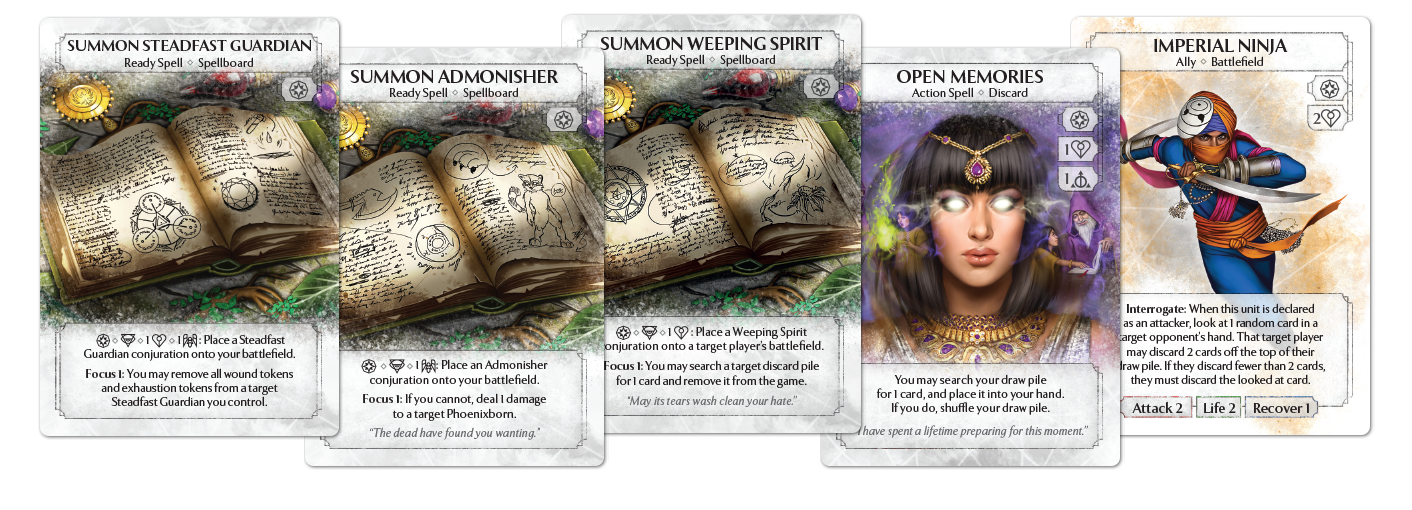
Because we’re winning with Admonishers, we need to get that gameplan snowballing as soon as possible, so the Open Memories is here to fetch a second book. We also want Steadfast Guardian since it’s one of the more robust summons available to us. Outside of that, we’ll need to pick into the matchup. Summon Weeping Spirit is pretty great against small battlefields (five and under) since the clog is pretty brutal and will need to be addressed. It can also be alright against larger battlefields as a problem that accumulates over time, but smaller battlefields are where the spirits shine. If the opponent has any kind of self-sacrifice effects like Brennen, replace the Weeping Spirit with Royal Charm. Imperial Ninja is pretty solid against other Charm decks or basically any opponent with 0 attack units, and can also be a solid aggressor against exhausted units (which shouldn’t be hard to find when playing Astrea). Law of Fear or Meteor can be amazingly effective against hyper aggressive decks. Finally, I like Holy Knight on a few rare occasions when playing an opponent that loves targeting my units with spells and shenanigans.
There’s also a more janky start where you use Open Memories to get a 2nd Steadfast book and start with Holy Relics. You’ll have a 3/5/1 Steadfast Guardian that you can refresh for two attacks right off the bat. I don’t recommend this, but if you want to flex, it’s an option.
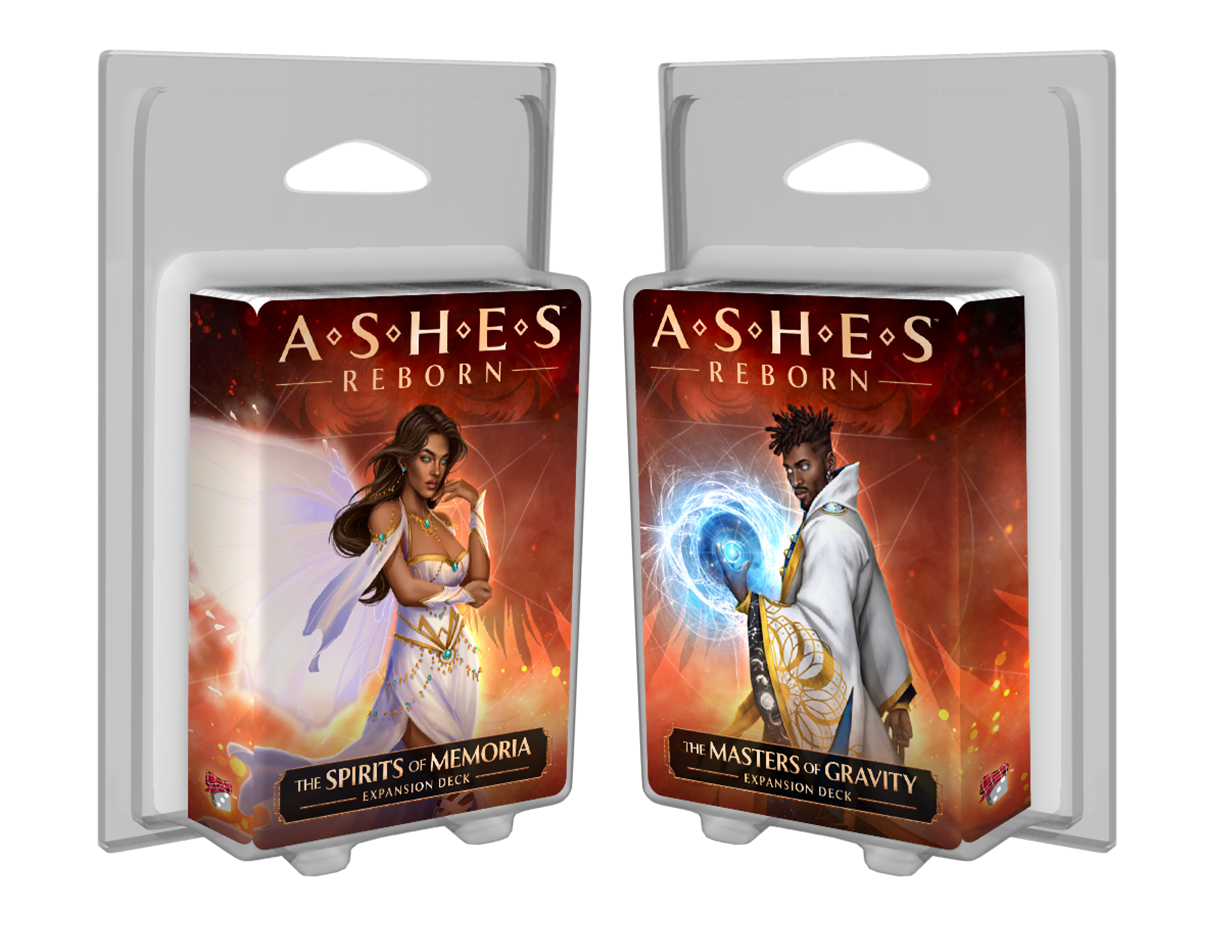
Alternate Translations:
We’re running Admonishers as our primary gameplan and it’s really hard to do that if you don’t have Admonishers, so you’ll definitely need The Spirits of Memoria to put this deck together; besides, the Chained Creations are a nice bonus. The Masters of Gravity is very solid, with Law of Fear being a truly magnificent means to stretch out our admonishments and Holy Relics works well with our Steadfast Guardians. That being said, we can potentially skirt by without Echo’s contributions, but that will put us on a tighter clock. Replace the Laws and Relics with more Sympathy Pains and either Memory Theft or Frost Bite to reinforce our burn gameplan. Redirect is also a valid option as losing an Admonisher isn’t so bad (we can just make another one). It will definitely be a little rough, but Astrea will prevail.
Taking it further:
Before suggesting replacements for this deck, I want to address Astrea’s crucial weakness: open attacking. Kneel, Beguile, Mark of the Goddess, Law of Fear and even Meteor are all incredible tools...unless your opponent just swings with everything at the start of the round, making all your tools completely useless. Most of how we address this is by blocking with all of our units and resummoning as needed (we probably won’t be killing any of our opponent’s units, but that’s actually fine), but against something big and terrifying, it really helps to have Redirect in your corner. If you’re splashing into other dice types, Illusion offers the amazingly solid Figures in the Fog and even Shadow Guard, while Time offers Stasis and the newly revealed Outmatch. Although, there is one particularly unique protection available in...basic?
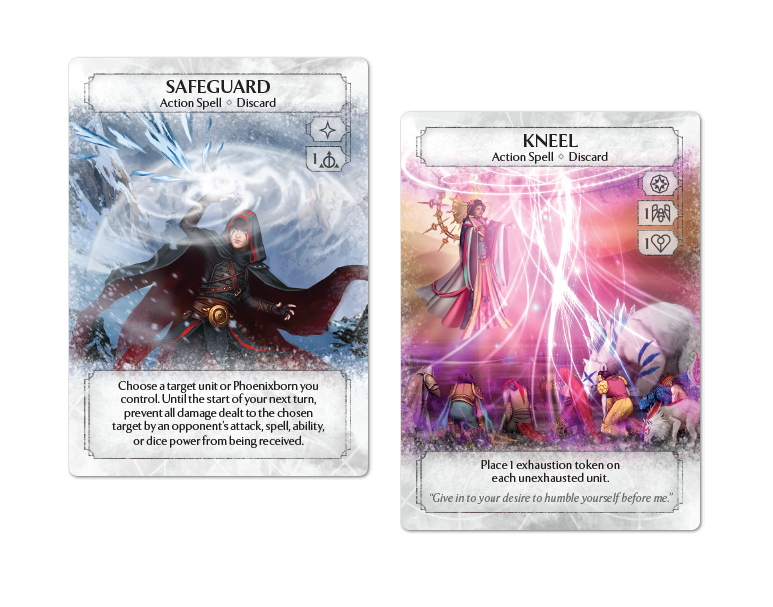
So, Safeguard originally made it in the deck, but was cut to avoid dipping into too many expansions. However, it’s a surprisingly powerful tool with Astrea, especially in decks that run Kneel or Law of Fear. The idea is to find the point where the round ends and cast Safeguard at that moment on Astrea, while taking a Pass for your main action. If you time it well or your opponent doesn’t have a main action to extend the round, you’ll keep the protection from Safeguard going into the next round. That means that even if your opponent goes first, they can’t actually deal damage to you before your next turn, giving you a window to perform any of your control tools and effectively “ruin” the round for your opponent. If you have Safeguard and want to try it here, I recommend running 2 copies, replacing 1 Sun Sister and 1 Chained Creations.
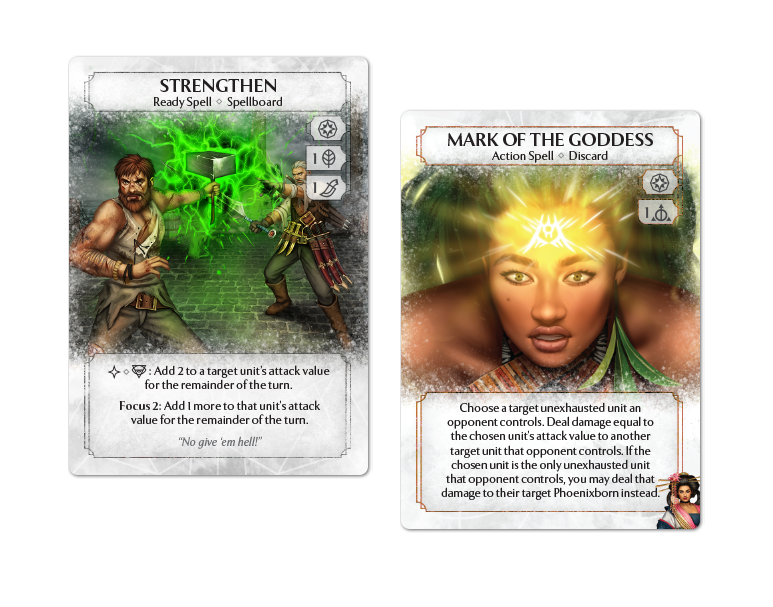
Finally, there’s another far more outlandish approach to Astrea that goes full burn with Natural and Ceremonial and likely abandons Charm entirely. I won’t talk about it in detail because it really feels like a completely different deck through and through, but I did want to mention the amazing synergy Mark of the Goddess has with Strengthen. In this rare occurrence, you actually use Strengthen to buff your opponent’s unit before using Mark to effectively add 2 value to the burn. It’s pretty spicy as burn strategies go, and might be worth messing around with just to see the look on your opponent’s face.
That’s all we’ve got for this article. Never let yourself be misguided. Especially by that jerk Harold. As we’ll see next time, he has a bad tendency of pulling on people’s heart strings...
Andrew DiLullo is an animator, a game designer, and luckily also a writer. Having first discovered Ashes at the tail end of the first round of expansions in 2016, he’s been playing ever since and currently heads the Bay Area Ashes group in California. He was especially active in several community projects after Ashes was canceled the first time, and now puts his attention to Reborn as the game starts anew. He’s currently designing a board game in his spare time, and occasionally writes on his online journal: The Lighthouse Library.


